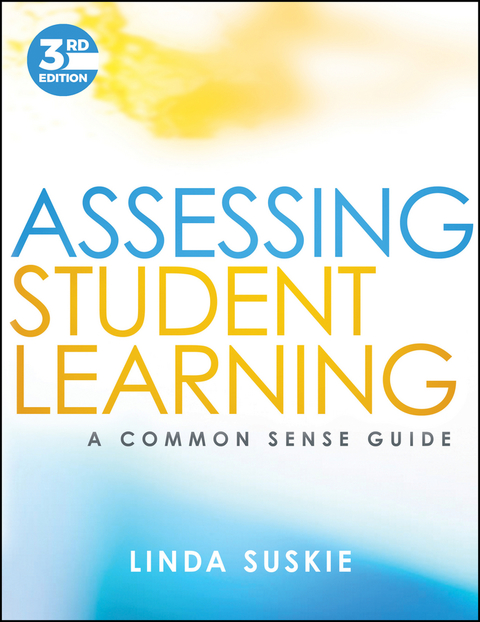Description
Efnisyfirlit
- Cover
- Title Page
- List of Tables
- List of Lists
- List of Figure
- List of Exhibits
- Preface to the Third Edition
- Introduction
- Part 1: Understanding Assessment
- CHAPTER 1: What Is Assessment?
- Time to think, discuss, and practice
- CHAPTER 2: The Many Settings for Student Learning and Assessment
- Time to think, discuss, and practice
- CHAPTER 3: What Are Effective Assessment Practices?
- Time to think, discuss, and practice
- Part 2: Laying a Foundation for Assessment Success
- CHAPTER 4: Learning Goals: Articulating What You Most Want Students to Learn
- What do students need to learn?
- Characteristics of effective learning goals
- How to identify what you most want students to learn
- Learning goals for specific settings
- Examples of meaningful, effective learning goals
- Integrating learning goals throughout your college
- Putting your learning goals to work
- Time to think, discuss, and practice
- CHAPTER 5: Designing Curricula to Help Students Learn What’s Important
- What are the characteristics of effective curricula?
- Curriculum design in specific settings
- Curriculum maps
- Other tools to understand curricula
- Using curriculum maps and other tools to improve curricula
- Curriculum review is not a one-and-done process
- Time to think, discuss, and practice
- CHAPTER 6: How Will Your Evidence of Student Learning be Used?
- Why are you assessing?
- What decisions will your evidence inform? Who will make them?
- Time to think, discuss, and practice
- CHAPTER 7: Planning Assessments in Academic Programs
- Choosing the best places in program curricula for assessment
- Choosing the best assessments for program learning goals
- Developing written plans that work out the logistics
- Regularly reviewing and updating your plans
- Time to think, discuss, and practice
- CHAPTER 8: Planning Assessments in General Education, Co-curricula, and Other Settings
- Planning assessments in general education curricula
- Planning assessments in co-curricula
- Planning assessments in other settings
- Time to think, discuss, and practice
- Part 3: Building a Pervasive, Enduring Culture of Evidence and Betterment
- CHAPTER 9: Guiding and Coordinating Assessment Efforts
- What guidance and coordination are needed?
- Who should provide guidance and coordination?
- Time to think, discuss, and practice
- CHAPTER 10: Helping Everyone Learn What to Do
- Time to think, discuss, and practice
- CHAPTER 11: Supporting Assessment Efforts
- Time
- Technologies
- Other resource needs
- Time to think, discuss, and practice
- CHAPTER 12: Keeping Assessment Cost-Effective
- Time to think, discuss, and practice
- CHAPTER 13: Collaborating on Assessment
- Time to think, discuss, and practice
- CHAPTER 14: Valuing Assessment and the People Who Contribute
- Time to think, discuss, and practice
- Part 4: The Assessment Toolbox
- CHAPTER 15: Designing Rubrics to Plan and Assess Assignments
- What is a rubric?
- Why use a rubric?
- Creating effective analytic rubrics
- Additional steps to consider
- Time to think, discuss, and practice
- CHAPTER 16: Creating Effective Assignments
- What is a great assignment?
- Crafting effective assignments
- Countering plagiarism
- Time to think, discuss, and practice
- CHAPTER 17: Writing Multiple-Choice and Other Objective Tests
- Planning an objective test
- Writing good multiple-choice items
- Pulling an objective test together
- Time to think, discuss, and practice
- CHAPTER 18: Assembling Evidence of Student Learning into Portfolios
- Time to think, discuss, and practice
- CHAPTER 19: Selecting Published Instruments
- Why use a published instrument?
- Identifying potential published instruments
- Evaluating potential published instruments
- Is a published instrument right for you?
- Time to think, discuss, and practice
- CHAPTER 20: Other Assessment Tools
- Reflective writing
- Rating scales
- Surveys
- Interviews and focus groups
- Journals
- Time to think, discuss, and practice
- CHAPTER 21: Assessing the Hard-to-Assess
- Some learning goals are promises we can’t keep
- We can’t see into the soul
- Performances are harder to assess than products
- Some learning goals can’t be assessed with graded assignments
- Time to think, discuss, and practice
- Part 5: Understanding and Using Evidence of Student Learning
- CHAPTER 22: Setting Meaningful Standards and Targets
- Choosing an appropriate perspective for comparison
- How to set an appropriately rigorous benchmark or standard
- How to set an appropriately rigorous target for the proportion of students achieving your standard
- Standard- and target-setting as iterative processes
- Time to think, discuss, and practice
- CHAPTER 23: Summarizing and Storing Evidence of Student Learning
- Planning your summary
- Summarizing quantitative evidence
- Summarizing qualitative evidence
- Documenting and storing evidence
- Time to think, discuss, and practice
- CHAPTER 24: Analyzing Evidence of Student Learning
- Answering the most important question: How well did students learn what you wanted them to learn?
- Answering another key question: Stewardship
- Documenting and analyzing the effectiveness of your assessment strategies
- Time to think, discuss, and practice
- CHAPTER 25: Sharing Evidence of Student Learning
- Share evidence in ways that will lead to decisions
- Create great visuals and reports
- Make evidence easy to find and access
- Be open, honest, balanced, and fair
- Share disappointing outcomes honestly and with context
- Share your assessment story with accreditors
- Move from sharing to action
- Time to think, discuss, and practice
- CHAPTER 26: Using Evidence of Student Learning to Inform Important Decisions
- Using student learning evidence to recognize and celebrate successes
- Use student learning evidence to give students the best possible education
- Use student learning evidence to ensure stewardship
- Changes to assessments don’t count
- Use student learning evidence for broad impact
- Use student learning evidence fairly, ethically, and responsibly
- Time to think, discuss, and practice
- References
- Index
- End User License Agreement






Reviews
There are no reviews yet.